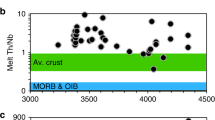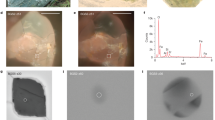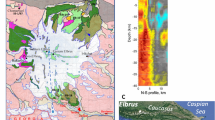Abstract
The first ∼600 million years of Earth history (the ‘Hadean’ eon) remain poorly understood, largely because there is no rock record dating from that era. Detrital Hadean igneous zircons from the Jack Hills1, Western Australia, however, can potentially provide insights into the conditions extant on our planet at that time. Results of geochemical investigations2,3,4,5,6,7,8,9,10,11,12,13 using these ancient grains have been interpreted to suggest the presence of a hydrosphere2,3,4,7,8 and continental crust9,10 before 4 Gyr. An underexploited characteristic of the >4 Gyr zircons is their diverse assemblage of mineral inclusions14,15,16,17. Here we present an examination of over 400 Hadean zircons from Jack Hills, which shows that some inclusion assemblages are conducive to thermobarometry. Our thermobarometric analyses of 4.02–4.19-Gyr-old inclusion-bearing zircons constrain their magmatic formation conditions to about 700 °C and 7 kbar. This result implies a near-surface heat flow of ∼75 mW m-2, about three to five times lower than estimates of Hadean global heat flow. As the only site of magmatism on modern Earth that is characterized by heat flow of about one-quarter of the global average is above subduction zones, we suggest that the magmas from which the Jack Hills Hadean zircons crystallized were formed largely in an underthrust environment, perhaps similar to modern convergent margins.
This is a preview of subscription content, access via your institution
Access options
Subscribe to this journal
Receive 51 print issues and online access
$199.00 per year
only $3.90 per issue
Buy this article
- Purchase on Springer Link
- Instant access to full article PDF
Prices may be subject to local taxes which are calculated during checkout



Similar content being viewed by others
References
Spaggiari, C. V., Pidgeon, R. T. & Wilde, S. A. The Jack Hills greenstone belt, Western Australia. Part 2: Lithological relationships and implications for the deposition of ≥4.0 Ga detrital zircons. Precambr. Res. 155, 261–286 (2007)
Mojzsis, S. J., Harrison, T. M. & Pidgeon, R. T. Oxygen-isotope evidence from ancient zircons for liquid water at the Earth's surface 4,300 Myr ago. Nature 409, 178–181 (2001)
Cavosie, A. J., Valley, J. W. & Wilde, S. A. Magmatic δ18O in 4400–3900 Ma detrital zircons: a record of the alteration and recycling of crust in the Early Archean. Earth Planet. Sci. Lett. 235, 663–681 (2005)
Trail, D. et al. Constraints on Hadean zircon protoliths from oxygen isotopes, REEs and Ti-thermometry. Geochem. Geophys. Geosyst. 8, Q06014 10.1029/2006GC001449 (2007)
Turner, G., Harrison, T. M., Holland, G., Mojzsis, S. J. & Gilmour, J. Extinct Pu-244 in ancient zircons. Science 306, 89–91 (2004)
Turner, G. et al. Pu–Xe, U–Xe, U–Pb chronology and isotope systematics of ancient zircons from Western Australia. Earth Planet. Sci. Lett. 261, 491–499 (2007)
Watson, E. B. & Harrison, T. M. Zircon thermometer reveals minimum melting conditions on earliest Earth. Science 308, 841–844 (2005)
Harrison, T. M. & Schmitt, A. K. High sensitivity mapping of Ti distributions in Hadean zircons. Earth Planet. Sci. Lett. 261, 9–19 (2007)
Harrison, T. M., Schmitt, A. K., McCulloch, M. T. & Lovera, O. M. Early (≥4.5 Ga) formation of terrestrial crust: Lu–Hf, δ18O, and Ti thermometry results for Hadean zircons. Earth Planet. Sci. Lett. 268, 476–486 (2008)
Harrison, T. M. et al. Heterogeneous Hadean hafnium: Evidence of continental crust at 4.4 to 4.5 Ga. Science 310, 1947–1950 (2005)
Amelin, Y. Sm–Nd systematics of zircon. Chem. Geol. 211, 375–387 (2005)
Caro, G. et al. Precise analysis of 142Nd/144Nd in small samples: Application to Hadean zircons from Jack Hills (W. Australia) and diamond inclusions from Finsch (S. Africa). Chem. Geol. 247, 253–265 (2008)
Maas, R. & McCulloch, M. T. The provenance of Archean clastic metasediments in the Narryer gneiss complex, Western Australia: Trace element geochemistry, Nd isotopes, and U–Pb ages from detrital zircons. Geochim. Cosmochim. Acta 55, 1915–1932 (1991)
Maas, R., Kinny, P. D., Williams, I. S., Froude, D. O. & Compston, W. The Earth’s oldest known crust: A geochronological and geochemical study of 3900–4200 Ma old detrital zircons from Mt Narryer and Jack Hills, Western Australia. Geochim. Cosmochim. Acta 56, 1281–1300 (1992)
Trail, D., Mojzsis, S. J. & Harrison, T. M. Inclusion mineralogy of pre-4.0 Ga zircons from Jack Hills, Western Australia: A progress report. Geochim. Cosmochim. Acta 68, A743 (2004)
Cavosie, A. J., Wilde, S. A., Liu, D., Weiblen, P. & Valley, J. W. Internal zoning and U–Th–Pb chemistry of Jack Hills detrital zircons: a mineral record of early Archean to Mesoproterozoic (4348–1576 Ma) magmatism. Precambr. Res. 134, 251–279 (2004)
Menneken, M., Nemchin, A. A., Geisler, T., Pidgeon, R. T. & Wilde, S. A. Hadean diamonds in zircon from Jack Hills, Western Australia. Nature 448, 917–920 (2007)
Anderson, J. L. Status of thermobarometry in granitic batholiths. Trans. R. Soc. Edinb. Earth Sci. 87, 125–138 (1996)
Massonne, H.-J. & Szpurka, Z. Thermodynamic properties of white micas on the basis of high-pressure experiments in the systems K2O-MgO-Al2O3-SiO2-H2O and K2O-FeO-Al2O3-SiO2-H2O. Lithos 41, 229–250 (1997)
Holland, T. J. B. & Powell, R. An internally consistent thermodynamic data set for phases of petrologic interest. J. Metamorph. Geol. 16, 309–343 (1998)
McLaren, S., Sandiford, M., Powell, R., Neumann, N. & Woodhead, J. Palaeozoic intraplate crustal anatexis in the Mount Painter Province, South Australia: Timing, thermal budgets and the role of crustal heat production. J. Petrol. 47, 2281–2302 (2006)
Coggon, R. & Holland, T. J. B. Mixing properties of phengitic micas and revised garnet-phengite thermobarometers. J. Metamorph. Geol. 20, 683–696 (2002)
Helz, R. T. Phase relations of basalts in their melting ranges at PH2O = 5 kb. Part II. Melt composition. J. Petrol. 17, 139–193 (1976)
Turcotte, D. L. & Schubert, G. Geodynamics: Applications of Continuum Physics to Geological Problems 2nd edn, 133 (Wiley, 2002)
Pollack, H. N., Hurter, S. J. & Johnson, J. R. Heat flow from the Earth's interior: analysis of the global data set. Rev. Geophys. 31, 267–280 (1993)
Bickle, M. J. Heat loss from the Earth: Constraints on Archaean tectonics from the relation between geothermal gradients and the rate of plate production. Earth Planet. Sci. Lett. 40, 301–315 (1978)
Abbott, D. H. & Hoffman, S. E. Archaean plate tectonics revisited. Part 1. Heat flow, spreading rate, and the age of subducting oceanic lithosphere and their effects on the origin and evolution of continents. Tectonics 3, 429–448 (1984)
Smith, J. V. The first 800 million years of Earth’s history. Phil. Trans. R. Soc. Lond. A 301, 401–422 (1981)
Sleep, N. L. Evolution of the mode of convection within terrestrial planets. J. Geophys. Res. 105, 17563–17578 (2000)
Bedini, R. M., Blichert-Toft, J., Boyet, M. & Albarede, F. Isotopic constraints on the cooling of the continental lithosphere. Earth Planet. Sci. Lett. 223, 99–111 (2004)
Blackwell, D. D., Steele, J. L. & Carter, L. S. in Neotectonics of North America (eds Slemmons, D. B., Engdahl, E. R. and Blackwell, D. D.) 423–437 (DNAG Decade Map 1, Geological Society of America, 1991)
White, R. W., Powell, R. W. & Holland, T. J. B. Calculation of partial melting equilibria in the system Na2O-CaO-K2O-FeO-MgO-Al2O3-SiO2-H2O (NCKFMASH). J. Metamorph. Geol. 19, 139–153 (2001)
Acknowledgements
This work was supported by NSF grant EAR-0635969 and ARC grant DP0666497. We acknowledge facility support from the Instrumentation and Facilities Program of the National Science Foundation. We thank R. Powell for advice on using THERMOCALC, F. Kyte for assistance with the EMPA analyses, A. Schmitt and P. Holden for assistance with the ion microprobe analyses, and W. Schopf and A. Kudryavtsev for confocal Raman imaging.
Author information
Authors and Affiliations
Corresponding author
Rights and permissions
About this article
Cite this article
Hopkins, M., Harrison, T. & Manning, C. Low heat flow inferred from >4 Gyr zircons suggests Hadean plate boundary interactions. Nature 456, 493–496 (2008). https://doi.org/10.1038/nature07465
Received:
Accepted:
Issue Date:
DOI: https://doi.org/10.1038/nature07465
This article is cited by
-
I-type and S-type granites in the Earth’s earliest continental crust
Communications Earth & Environment (2023)
-
When and How Plate Tectonics Began?
Journal of Earth Science (2023)
-
Hadean/Eoarchean tectonics and mantle mixing induced by impacts: a three-dimensional study
Progress in Earth and Planetary Science (2022)
-
Coexisting divergent and convergent plate boundary assemblages indicate plate tectonics in the Neoarchean
Nature Communications (2022)
-
Eoarchean subduction-like magmatism recorded in 3750 Ma mafic–ultramafic rocks of the Ukaliq supracrustal belt (Québec)
Contributions to Mineralogy and Petrology (2022)
Comments
By submitting a comment you agree to abide by our Terms and Community Guidelines. If you find something abusive or that does not comply with our terms or guidelines please flag it as inappropriate.



